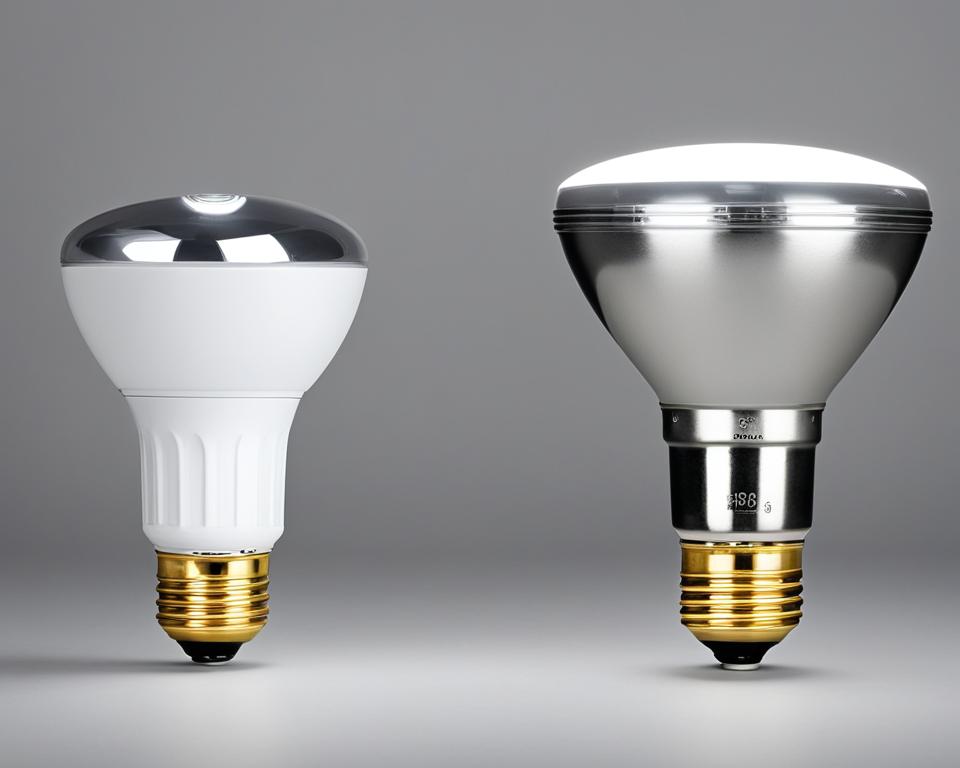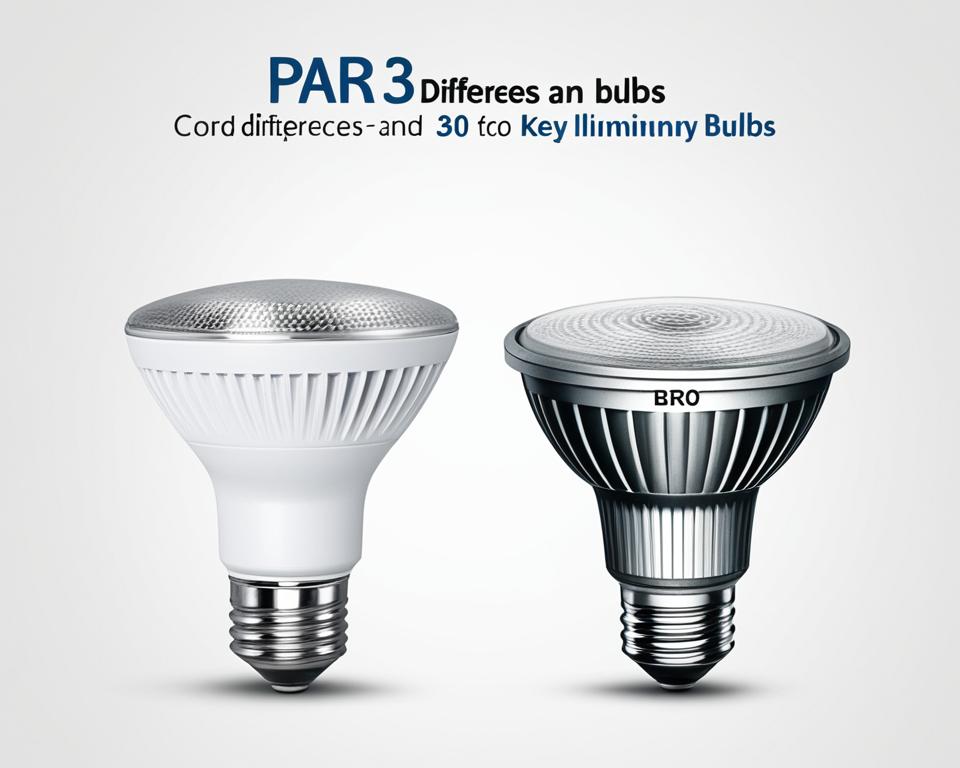When it comes to choosing the right lighting for your space, it’s important to understand the differences between PAR30 and BR30 bulbs. Both types of bulbs are commonly used in 4″ recessed lighting cans, but they have distinct characteristics that make them better suited for different applications.
The main difference between PAR30 and BR30 bulbs lies in their light distribution. BR30 bulbs are designed for general lighting, providing consistent and uniform light throughout a room. They are perfect for illuminating larger areas and creating a welcoming ambiance. On the other hand, PAR30 bulbs are known for their ability to emphasize specific areas or objects. They often create a sharper edge and more pronounced shadows, making them ideal for accent lighting and highlighting architectural features.
Key Takeaways:
- PAR30 bulbs are better for accent lighting, while BR30 bulbs are ideal for general lighting.
- Both PAR30 and BR30 bulbs are commonly used in 4″ recessed lighting cans.
- PAR30 bulbs offer two neck options (short and long), while BR30 bulbs do not.
- PAR30 bulbs are often wet rated, making them suitable for outdoor use.
- LED options are available for both PAR30 and BR30 bulbs, providing energy efficiency and long lifespan.
How to Choose Between PAR30 and BR30 Bulbs
When deciding between PAR30 and BR30 bulbs, it’s important to consider the intended purpose of the lighting. Each bulb type has its unique characteristics and advantages that cater to different lighting needs.
- If you’re looking for general lighting in a room, BR30 bulbs are a good choice. These bulbs provide consistent light distribution, illuminating the entire space evenly.
- On the other hand, if you want to highlight specific areas or objects, PAR30 bulbs can create a more focused and accentuated lighting effect. The spotlight-like beam of PAR30 bulbs is perfect for drawing attention to artwork, architectural features, or any other points of interest in your space.
Both PAR30 and BR30 bulbs are available in energy-efficient LED options, which offer long lifespan and cost savings. When considering LED bulbs, look for the Energy Star certification to ensure optimal energy efficiency and performance.
Another factor to consider is the size and design of your lighting fixture. PAR30 bulbs come with two neck options: short necks for track lighting and long necks for recessed lighting cans. This versatility allows you to choose the bulb that fits your specific fixture perfectly. On the other hand, BR30 bulbs typically have a standard neck size, which may limit their compatibility with certain fixtures.
If you plan on using the bulbs outdoors, it’s essential to check for a wet rating, especially if moisture exposure is a concern. While some PAR30 bulbs are wet rated, providing protection against water intrusion, BR30 bulbs are usually not suitable for outdoor use due to their lack of wet rating.

“The right choice between PAR30 and BR30 bulbs depends on your specific lighting needs and preferences. Consider factors such as the desired lighting effect, compatibility with your fixtures, and the need for wet rating in outdoor applications.”
Understanding the Differences Between PAR30 and BR30 Bulbs
The primary difference between PAR30 and BR30 bulbs lies in their beam angles and light distribution. PAR30 bulbs have a beam angle of 45 degrees, creating a more focused and targeted lighting effect. On the other hand, BR30 bulbs have a wider beam angle of around 100-120 degrees, providing a broader coverage of light.
This difference in beam angles makes BR30 bulbs more suitable for general lighting and illuminating larger areas, while PAR30 bulbs excel at highlighting specific areas or objects with a more concentrated beam.
In terms of brightness, both bulb types can offer similar levels of illumination depending on the specific model and wattage. However, it’s important to note that LED options for both PAR30 and BR30 bulbs are generally more energy-efficient and produce less heat compared to traditional incandescent or halogen bulbs. This makes them a more environmentally friendly and cost-effective choice in the long run.
To summarize:
- PAR30 bulbs have a beam angle of 45 degrees, providing focused and targeted lighting.
- BR30 bulbs have a wider beam angle of 100-120 degrees, offering broader coverage of light.
- Both PAR30 and BR30 bulbs can provide similar levels of brightness depending on the specific model and wattage.
- LED options for both bulb types are more energy-efficient and produce less heat compared to traditional bulbs.
| Bulb Type | Beam Angle | Light Distribution | Brightness | Energy Efficiency |
|---|---|---|---|---|
| PAR30 | 45 degrees | Focused and targeted | Similar to BR30 | LED options available for energy savings |
| BR30 | 100-120 degrees | Broader coverage of light | Similar to PAR30 | LED options available for energy savings |
Note: It’s important to consider your specific lighting needs and preferences when choosing between PAR30 and BR30 bulbs. If you require more focused lighting or want to highlight specific areas or objects, PAR30 bulbs may be the better choice. On the other hand, if you need general lighting or broader coverage, BR30 bulbs are a suitable option. Both bulb types are available in LED options, providing energy efficiency and long-lasting performance.

Considerations for Outdoor Lighting: PAR30 vs BR30
When it comes to outdoor lighting, choosing between PAR30 and BR30 bulbs requires careful consideration of several factors. One of the most crucial considerations is the wet rating of the bulbs, especially if they will be exposed to direct water or high levels of moisture. While some PAR30 bulbs are wet rated, BR30 bulbs are generally not. It is essential to verify that the bulbs you choose meet your specific wet rating requirements by checking the packaging or online listing.
Another important aspect to consider is the desired lighting effect for your outdoor space. PAR30 bulbs are known for their ability to create a more focused and accentuated lighting effect, making them ideal for highlighting specific areas or objects in outdoor environments. On the other hand, BR30 bulbs offer a wider coverage of light, making them more suitable for general illumination purposes.
Now, let’s take a closer look at the differences between the two bulb types for outdoor lighting:
| Factors | PAR30 Bulbs | BR30 Bulbs |
|---|---|---|
| Wet Rating | Some PAR30 bulbs are wet rated | BR30 bulbs are usually not wet rated |
| Lighting Effect | Creates a focused and accentuated lighting effect | Offers a wider coverage of light |
As seen in the table above, the wet rating is an important consideration for outdoor lighting. If you need wet rated bulbs, it is advisable to choose PAR30 bulbs. Additionally, understanding the desired lighting effect will help determine whether PAR30 or BR30 bulbs are the right choice for your outdoor space.
In terms of energy efficiency, both PAR30 and BR30 bulbs are available in LED options, which provide long-lasting performance and reduced energy consumption compared to traditional incandescent or halogen bulbs. This makes them suitable for environmentally conscious outdoor lighting solutions.
With these considerations in mind, you can now make an informed decision about whether PAR30 or BR30 bulbs are the best choice for your outdoor lighting needs.

Conclusion
When deciding between PAR30 and BR30 bulbs for your lighting needs, it’s important to consider various factors to make the right choice. Both bulb types offer distinct advantages and can be suitable for different applications.
If you’re looking for general lighting with consistent light distribution throughout a room, BR30 bulbs are a great option. Their wider beam angle provides a broader coverage of light, making them ideal for illuminating larger areas. On the other hand, if you want to highlight specific areas or objects, PAR30 bulbs with their focused beam angle can create a more accentuated lighting effect, adding depth and creating a dramatic ambiance. It’s essential to evaluate the desired lighting effect based on your preferences and the specific needs of your space.
In terms of energy efficiency, both PAR30 and BR30 bulbs are available in LED options. LED bulbs offer exceptional energy efficiency and long lifespan, making them a sustainable and cost-effective choice. Additionally, if you require wet-rated bulbs for outdoor use, it’s important to note that PAR30 bulbs are commonly wet rated, while BR30 bulbs usually are not.
Before making a final decision, it’s recommended to compare the specifications and features of different PAR30 and BR30 bulbs. Consider the size and design of your lighting fixtures, the lighting effect you desire, and any specific requirements for outdoor use. By keeping these factors in mind, you can make an informed decision that meets your lighting needs and preferences while ensuring energy efficiency and optimal performance.
FAQ
What are the differences between PAR30 and BR30 bulbs?
The main difference between PAR30 and BR30 bulbs lies in their light distribution. BR30 bulbs are ideal for general lighting, providing consistent light throughout a room, while PAR30 bulbs are better at emphasizing certain areas or objects.
Do PAR30 and BR30 bulbs have the same size?
Yes, both PAR30 and BR30 bulbs have a face width of 3.75 inches, making them suitable for common 4″ recessed lighting cans.
Can both PAR30 and BR30 bulbs be used outdoors?
PAR30 bulbs are more often wet rated for outdoor use, while BR30 bulbs are usually not.
Which bulbs are better for general lighting?
BR30 bulbs are a good choice for general lighting as they provide consistent light distribution.
Which bulbs are better for accent lighting?
PAR30 bulbs can create a more focused and accentuated lighting effect, making them suitable for highlighting specific areas or objects.
Are LED options available for both PAR30 and BR30 bulbs?
Yes, both PAR30 and BR30 bulbs are available in LED options, offering energy efficiency and long lifespan.
What factors should I consider when choosing between PAR30 and BR30 bulbs?
Consider factors such as the desired lighting effect, the size and design of the lighting fixture, and whether you need a wet rated bulb for outdoor use.
What is the beam angle for PAR30 and BR30 bulbs?
PAR30 bulbs have a beam angle of 45 degrees, while BR30 bulbs have a wider beam angle of around 100-120 degrees.
Are PAR30 and BR30 bulbs available in different brightness levels?
Both bulb types can offer similar levels of illumination depending on the specific model and wattage.
Which type of bulb is more energy efficient?
LED options for both PAR30 and BR30 bulbs are recommended for their energy efficiency and long lifespan.
